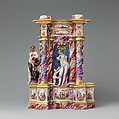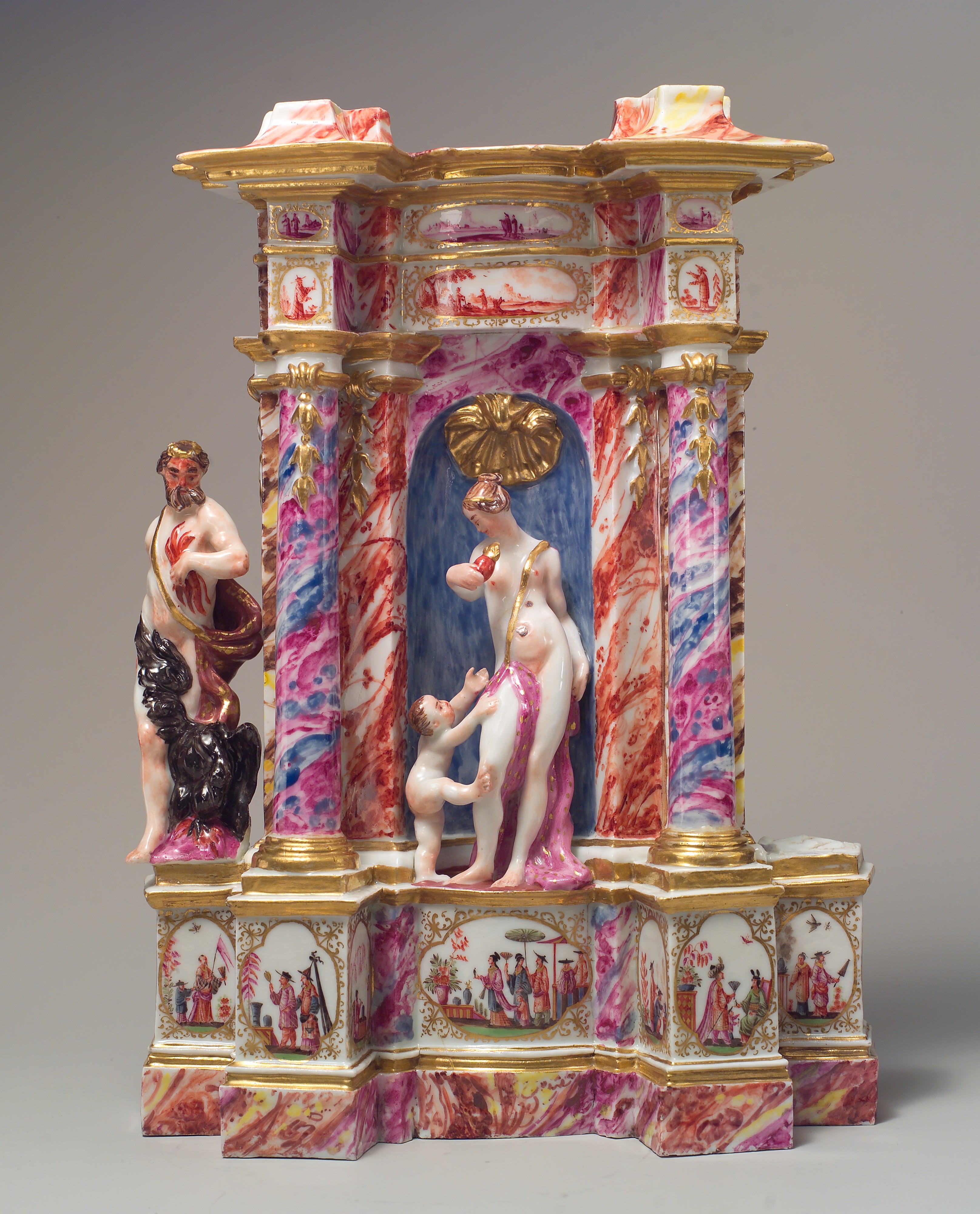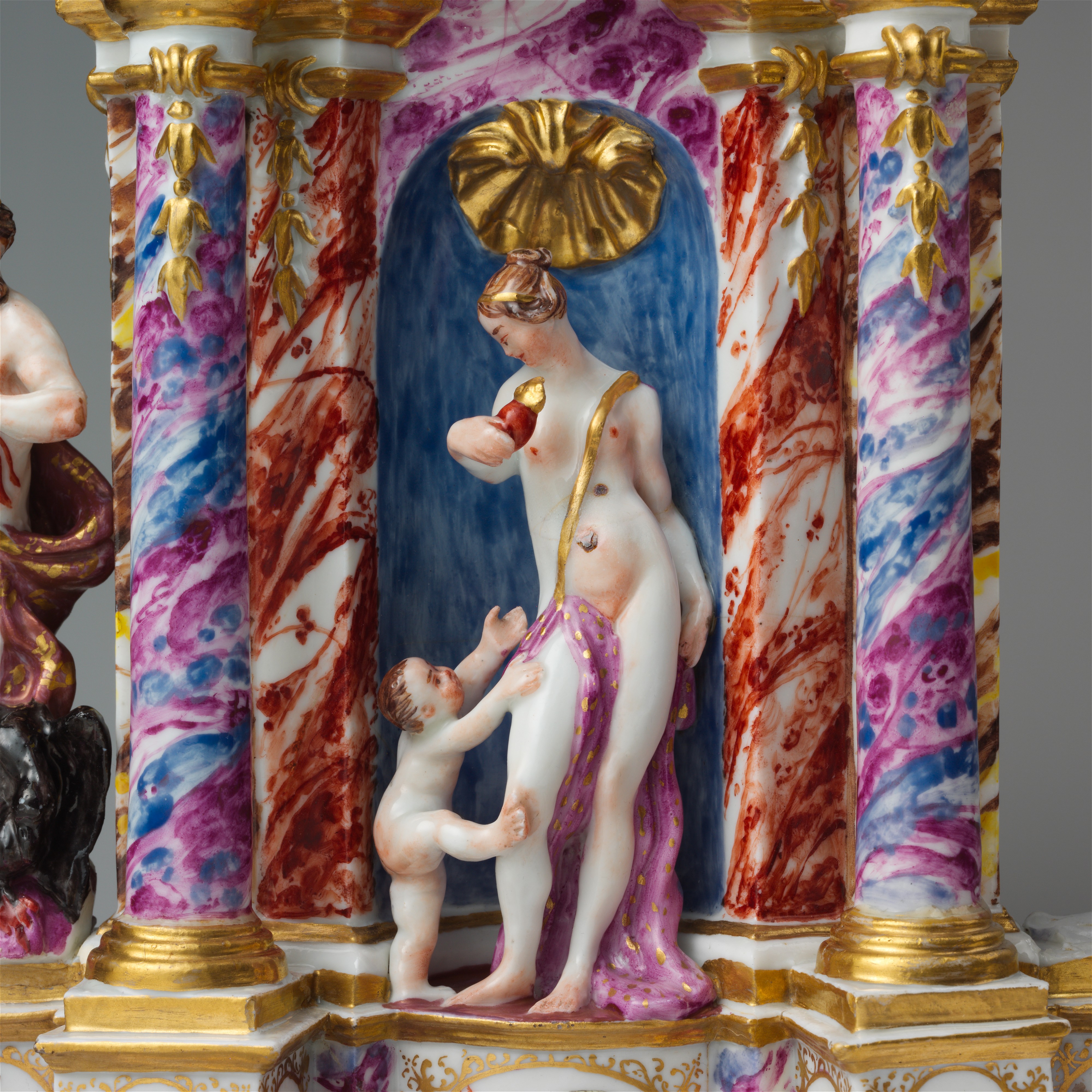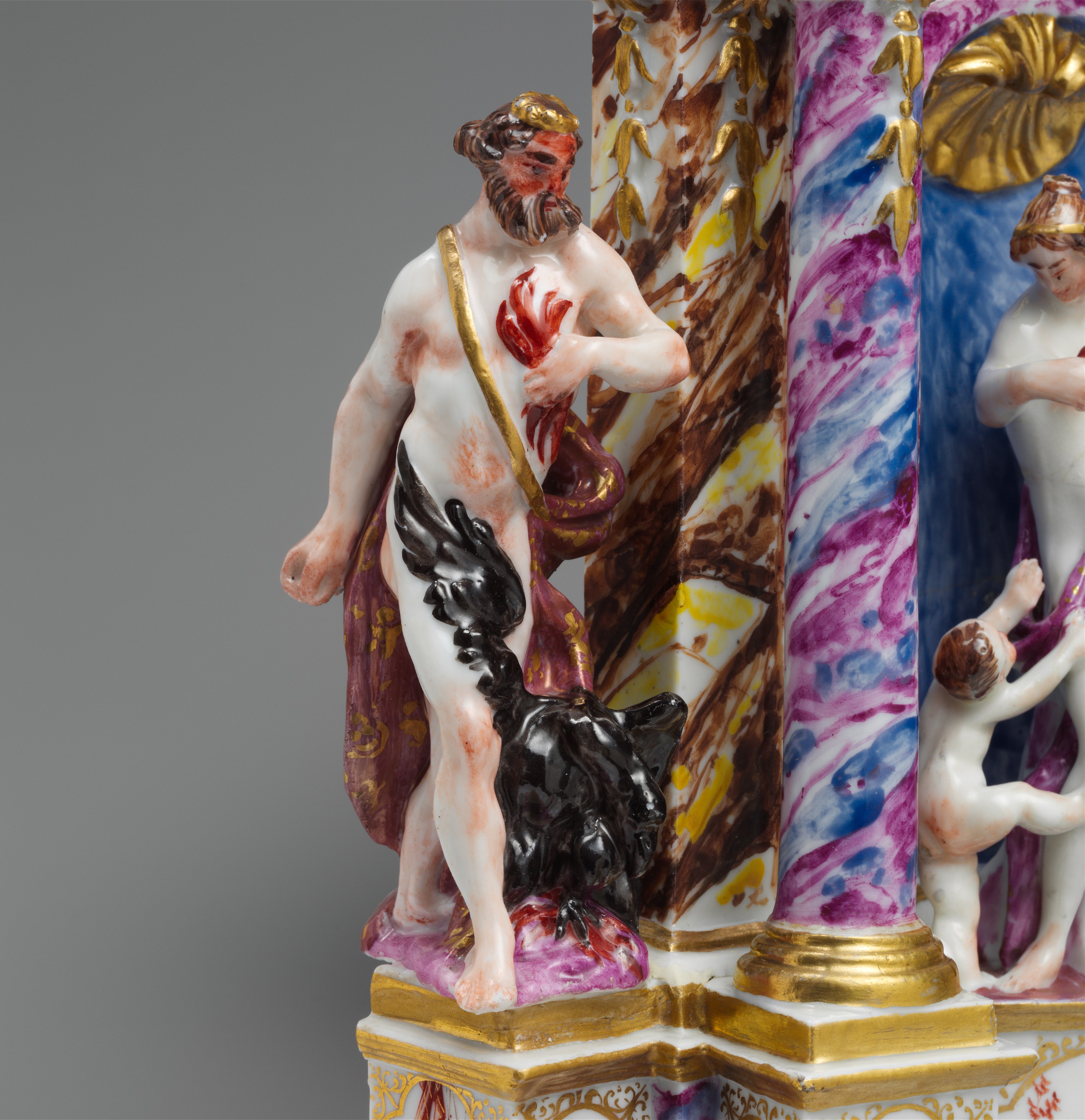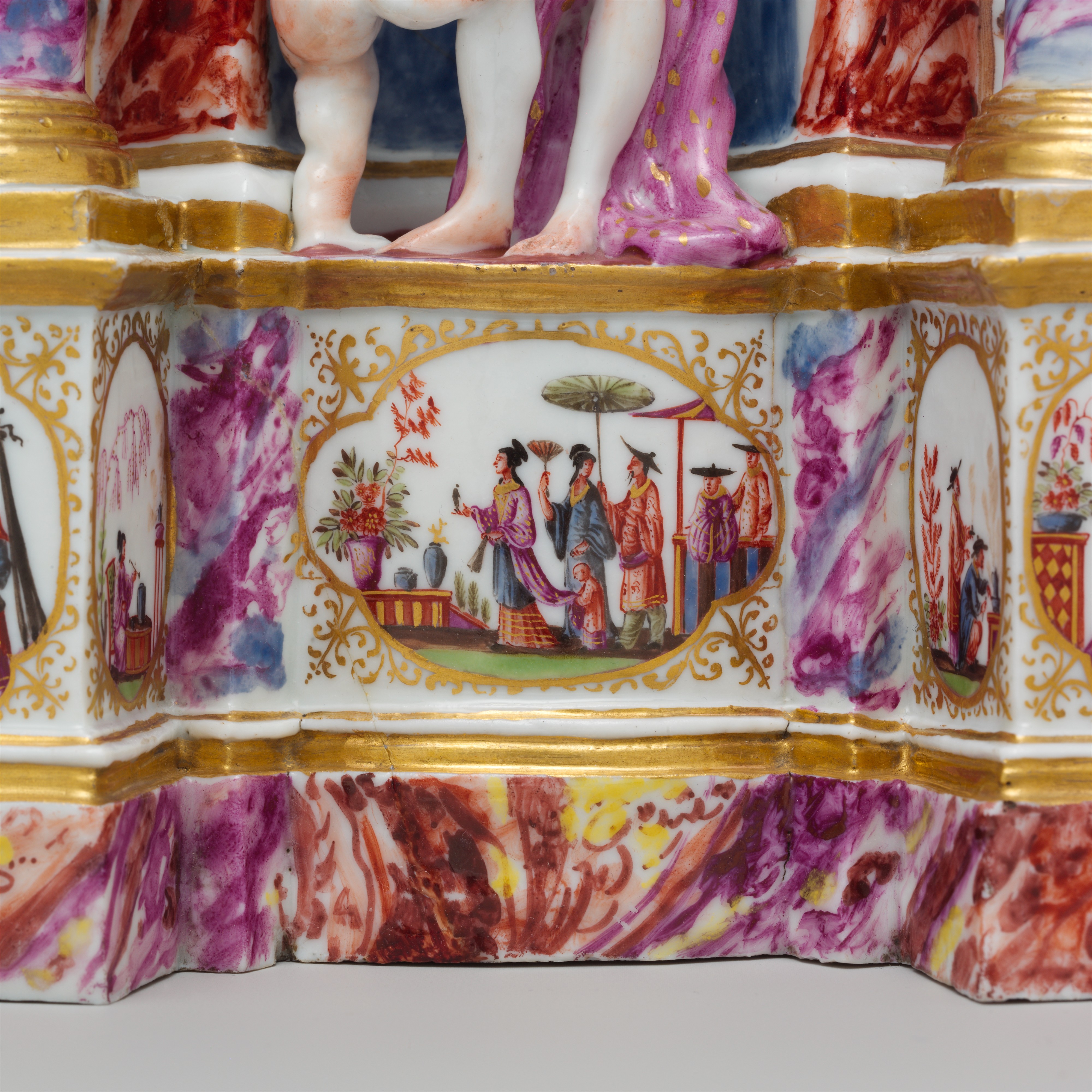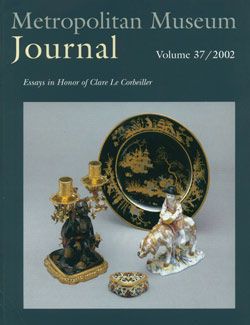Temple of Venus
Manufactory Meissen Manufactory German
Modeler Johann Gottlieb Kirchner German
Not on view
The form of this remarkable porcelain sculpture recalls that of a triumphal arch, though the center of this object is occupied by a niche flanked by Roman Ionic columns. Standing in the niche are the figures of Venus, who holds a flaming heart, and a cupid, who reaches toward her. The structure’s tall base extends on either side, showing the figure of Jupiter with his eagle to the left, and an empty space to the right, where the figure of Juno almost certainly would have stood but clearly has been broken off. Above the niche is a double entablature with sloping roofs at both ends, and a central depressed, undecorated area in which another figure presumably would have been placed.[1] The architectural quality of the structure has been emphasized by the decorative marbling of the base, the columns, the pilasters located behind the columns, and the sloping roofs at the top. Curiously, the decorative scheme also includes a series of reserves with chinoiserie scenes that do not appear to be related to either the mythological figures or to the strong architectural aspect of the sculpture. The contrast between the finely painted quality of the small-scale chinoiserie scenes and the loosely executed marbling creates a surprising aesthetic effect that, in combination with the relatively unsophisticated modeling of the two figures, makes the Venus Temple unlike anything else produced at Meissen during the late 1720s. It is important to view the sculpture as one of the earliest works to have been created by the first sculptor employed by the factory, and from this perspective, it must be regarded as a highly ambitious undertaking.
From contemporary factory records, it is known that Johann Gottlieb Kirchner (German, b. 1706) created the model for the sculpture, referred to in original documents as the Venus Tempel, in July 1727.[2] Three examples of the Venus Temple were recorded in the Meissen inventory in July 1729,[3] and two were ordered in 1733 for delivery to the Japanese Palace in Dresden.[4] Another Venus Temple is known to survive today, and on this example, now in the collections of the Rijksmuseum, Amsterdam, the three mythological figures, including that of Juno, are intact.[5] While the choice to create a Venus Temple in porcelain may seem unexpected for the Meissen factory, temples devoted to the Goddess of Love created in other media had both an immediacy and an elevated status in Dresden court circles. A large, two-tiered Venus Temple had served as the primary table decoration at a dinner held in Dresden in 1719 to celebrate the wedding of the Crown Prince Frederick August II (1696–1763) to Maria Josepha (1699–1757), daughter of Holy Roman Emperor Joseph I (1678–1711).[6] The decorations and protocol established for this wedding were considered so successful that they established the model for future royal weddings in Dresden.[7]
Even though it might seem logical to assume that the porcelain Venus Temple was created to serve as table decoration, its early date of production indicates that it would not have been displayed on the dining or dessert table. It was not until the mid-1730s that porcelain sculpture would begin to play a major role in decorating the table, gradually replacing the long-established practice of creating sugar sculptures to serve as the decorative elements. It is not known specifically how the two Venus Temples ordered for the Japanese Palace were intended to be displayed, but they were part of a very large order of vases, tea services, plates, tureens, and figures, all of which would have been installed decoratively on the walls.[8]
In modeling the Venus Temple, Kirchner drew upon sources with which he was familiar. His older brother, Johann Christian Kirchner (German, 1691–1732), worked with the court sculptor Balthasar Permoser (German, 1651– 1732) on the decorative program for the Zwinger Palace in Dresden, a complex used for display and entertainment, which was constructed from 1710 to 1728. Three garden sculptures by Permoser served as models for the figures created for the Venus Temple, and two of these works by Permoser were made for the Zwinger.[9] The third sculpture by Permoser, the figure of Venus, was produced for a garden in a manor house in Borna,[10] a town located to the west of Dresden, which may have been accessible to the younger Kirchner through his brother. Elements of the architecture of the Venus Temple recall the Zwinger as well. Abraham L. den Blaauwen has noted the sloping roofs atop the Venus Temple are similar to those found on the Nymphenbad, an elaborate architectural fountain within the Zwinger complex.[11] The distinctive low-relief, foliate decoration on the columns of the Venus Temple echo similar carved ornament on columns found within the Zwinger.[12]
It is not surprising that Kirchner looked to sources close at hand for inspiration for his Venus Temple. Sculptural production of European subjects was still in its infancy at Meissen, and no repertoire of figural types had yet been established. Furthermore, there was a natural association between the court architecture created for August II (1670–1733), commonly known as Augustus the Strong, elector of Saxony, king of Poland, and the porcelain produced at Meissen to decorate one of his palaces. The strongly architectural nature, as exemplified by the Venus Temple, was not a stylistic direction that Meissen would explore in depth, but the depiction of figures in the European tradition would soon become one of the defining aspects of the factory’s production.
Footnotes
(For key to shortened references see bibliography in Munger, European Porcelain in the Metropolitan Museum of Art. NY: The Metropolitan Museum of Art, 2018)
1 It has been suggested that a figure of Cronos may have surmounted the sculpture; Cassidy-Geiger 2002b, p. 166, n. 56.
2 Blaauwen 2000, pp. 101–2.
3 Ibid., p. 101.
4 Cassidy-Geiger 1996b, p. 122. More recent information suggests that the Specification dates from 1733 rather than 1736; Cassidy-Geiger 2002a, p. 34, n. 31.
5 Blaauwen 2000, pp. 100–102, no. 50.
6 Cassidy-Geiger 2002a, p. 29, fig. 15.
7 Ibid., pp. 29–30.
8 Cassidy-Geiger 1996b.
9 Cassidy-Geiger 2002b, p. 166, n. 56. Two other garden sculptures by Permoser have been proposed as the sources for the porcelain figures of Jupiter and Juno; Blaauwen 2000, p. 101. It is also possible that Kirchner was working from drawings attributed to his brother for the figures of Jupiter and Juno; Blaauwen 2000, p. 102.
10 Cassidy-Geiger 2002b, p. 166, n. 56.
11 Blaauwen 2000, p. 101.
12 See Asche 1978, figs. 218, 232, 235; Blaauwen 2000, p. 101.
This image cannot be enlarged, viewed at full screen, or downloaded.
This artwork is meant to be viewed from right to left. Scroll left to view more.
